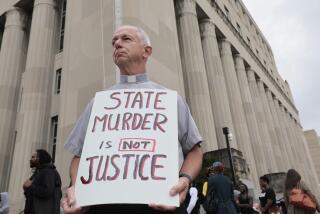Unfairness Is Underscored
The decision last week by the U.S. Supreme Court that an insane criminal may not be executed shows yet again the virtual impossibility of administering the death penalty in a way that is rational, equitable and fair. Five justices agreed that the constitutional prohibition against cruel and unusual punishment bars states from executing a murderer who has become insane while on Death Row. But the justices could not agree on what procedures must be used to determine the sanity of a condemned person before he is put to death.
Seven justices said that the sanity determination may not be based solely on psychiatric reports by state psychiatrists and that the murderer’s lawyer must be allowed to present evidence. But they disagreed over whether the determination must be made in court or may be done administratively. They also disagreed over whether a hearing must be conducted or whether written filings are enough. If the Supreme Court cannot agree on what is proper, what chance is there that the states will do a better job of it?
And what are psychiatrists supposed to do now? Should they treat and try to cure condemned people who are insane? If their intervention is successful, their patients will be executed.
The court’s ruling may affect as many as 400 of the 1,700 persons awaiting execution in the United States, and many more people now and in the future will feign insanity in an effort to stay alive. Some of them are likely to be successful, and some truly insane people are likely to be judged competent and executed. Trying to determine who is sane and who is not, which the Constitution requires, will make the imposition of the death penalty even more capricious than it already is.
The evidence is clear: Whether a convicted murderer gets the death penalty is largely related to arbitrariness and race. In the 41 states in this country that have capital punishment, courts in some areas impose that sentence more often than do courts in other areas. And blacks are far more likely to be sentenced to die than are whites, particularly if the victim was white. In Florida, for example, a black person convicted of killing a white person has a one-in-five chance of being sent to the electric chair. But no white person who killed a black person has ever been executed there.
Though states have tried since 1972 to make capital sentencing more equitable, they have not succeeded. Last week’s decision underscores the unfairness that permeates the system. It remains for the court to draw the appropriate conclusion and sweep away the death penalty as inherently unconstitutional.
More to Read
Sign up for Essential California
The most important California stories and recommendations in your inbox every morning.
You may occasionally receive promotional content from the Los Angeles Times.










